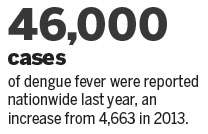Drones help rein in mosquito breeding
Updated: 2015-09-15 08:21
By Zheng Caixiong in Guangzhou(China Daily)
|
||||||||
Aerial drones have become part of the prevention effort against dengue fever in Guangdong province, after the epidemic peaked last summer.
In Chaozhou, drones buzz around the skies over Xiangqiao district. Within minutes, they bring back photos of the district's roofs, pinpointing those with pools of water that could serve as breeding grounds for mosquitoes, which spread the disease.
Xiangqiao district reported 257 dengue fever cases as of Saturday.
"Using drones is a new and effective measure to help remove hidden dangers and prevent an outbreak," said a neighborhood committee official, surnamed Zhuang.
According to Zhuang, nine drones are collecting the aerial photos.
The Guangdong Center for Disease Control and Prevention said dengue fever usually peaks in the province between May and November. But the number of cases has sharply dropped this year compared with last year.
Last year, China reported 46,000 cases of dengue fever, with 43,200 were in Guangdong. That's up dramatically from the mere 4,663 cases reported nationwide in 2013.

Experts attribute dengue fever's rise in China to frequent interaction of people with Southeast Asian countries, where incidence of the disease has been climbing. People who travel to affected countries can carry the disease back with them.
Last year, Guangdong had six deaths from dengue fever, according to the provincial disease control center.
Dengue fever is passed to humans by mosquitoes. Symptoms of the flulike disease include headaches, rashes, lethargy and joint and bone pain.
Various measures have been taken to fight the epidemic. Besides the use of drones to pinpoint water pools, 500,000 to 600,000 specially bred male mosquitoes that cause their mating partners to become infertile are being released on an island every week as a test.
Eggs produced by female mosquitoes that mated with wolbachia-bearing males were not viable, researchers found. The technique reduced the mosquito population in some areas of the island by 90 percent, according to a report by Southern Metropolis Daily.
The mosquitoes were produced at a science park "factory" in Guangdong, which opened on July 17.
It has the capacity to produce up to 10 million male mosquitoes every week that are infected with wolbachia, a bacteria that exists widely in many insects, the report said.
zhengcaixiong@chinadaily.com.cn

 Man tries to sell kidney for iPhone 6s
Man tries to sell kidney for iPhone 6s
 Gems of Chinese painting at Sotheby's HK auction
Gems of Chinese painting at Sotheby's HK auction
 NYFW: Tommy Hilfiger Spring/Summer 2016 collection
NYFW: Tommy Hilfiger Spring/Summer 2016 collection
 Bus decorated with 3D painting goes into service
Bus decorated with 3D painting goes into service
 Top 10 tire companies in the world
Top 10 tire companies in the world Djokovic beats Federer to win second US Open title
Djokovic beats Federer to win second US Open title
 The world in photos: Sept 7-13
The world in photos: Sept 7-13
 Hanging in the air: Workers risk life on a suspension bridge
Hanging in the air: Workers risk life on a suspension bridge
Most Viewed
Editor's Picks

|

|

|

|

|

|
Today's Top News
Parade attendees tell Houston of honor
Boeing plan for finishing center to stir up China market
Illegal margin debts probe won't crash markets: CSRC
Prisoners on death row to get free legal aid
Kissinger anticipates promising China-US ties
Germany re-imposes border controls to slow migrant arrivals
Thousands flee California wildfire as homes go up in flames
Museum crowds wait six hours to see ancient scroll
US Weekly

|

|







